COA would like to congratulate Alternative Family Services (AFS), a Resource Family Agency and mental health service provider serving Northern California, as winner of the 2020 Innovative Practices Award for its “Enhanced Visitation Model: Foster Care” program!
The Innovative Practices Award identifies, documents, and celebrates examples of successful approaches to management and service delivery practices adopted by our accredited organizations. Too often great ideas are kept in-house, without recognizing their potential to create change beyond. The purpose of the Innovative Practices Award is to amplify the effect of one great idea by elevating it to the national stage and offering it as a resource for direct service providers, leadership, researchers, and advocates across the full spectrum of human services.
This year, innovation is more important than ever. The COVID-19 pandemic has challenged every sector of our society, but it has presented special obstacles for the human and social services field. 2020 has also reinforced the urgent need for better equity, diversity, and inclusion. With that in mind, COA requested that Innovative Practices Award submissions address one or both topics.
This year’s evaluation process began with a preliminary round of submissions in which applicants provided a one-page synopsis of their innovative practice. Four finalists were selected to move forward and submitted their full case studies, which were reviewed by a team of expert judges. The community got to weigh in, as well, with hundreds of public votes making up 5% of each submission’s final score.
You can view the case study of the Enhanced Visitation Model program here.
ABOUT THE ENHANCED VISITATION MODEL PROGRAM
Visitation frequency between parent and child is one of the strongest predictors of successful family reunification within the foster care system. The initial response to the COVID pandemic for many agencies and institutions charged with overseeing family visitation was to restrict face to face services. Even as government and private agencies have begun to reinstitute face-to-face visitation, it is clear that the pandemic will ebb and flow. If visitation is going to be available to all families, some families will need to practice social distancing or utilize virtual technologies during visitation in order to contain contagion and meet foster parent fears and demands for safety. Families involved in the foster care system are often distrustful of how resources are allocated and rules are applied. When restrictions are placed upon parents’ right to visit their child, it is imperative that the process be transparent and equitable. To accomplish its purpose, the visitation experience must also be positive and encourage healthy interaction.
AFS’ Enhanced Visitation Model incorporates risk assessment and visit planning tools to assist staff in developing transparent and equitable visitation plans for all families. They have coupled this with replicable visitation activities or venues that can safely provide a continuum of healthy visit experiences regardless of risk level. Three levels of visitation service delivery address the special needs of families required to adhere to community, social distancing, or quarantine requirements. AFS’ Enhanced Visitation Model is designed to inspire clients and parents to play and communicate freely while minimizing the potential for client and family re-traumatization that can be caused by difficult to enforce rules and restrictive visitation environments. Their Enhanced Visitation Model is intentionally easy to replicate. They hope their model inspires and encourages family visitation providers to address the challenges of the COVID19 environment with innovative and creative visitation practices for all the families they serve.
Learn more about Alternative Family Services at afs4kids.org.
A big thank you to Shondelle Wills-Bryce, MSW of Sisters Keeping InTouch, inspires, LLC for this guest post!
The peace and serenity of a spring morning is undeniable. Take a moment wherever you are and observe the synergy of nature surrounding you. During my moment, I heard birds chirping, I felt the cool breeze on my arms, and I saw greenery all around. I smiled in amazement, thinking about how nature seemingly effortlessly comes together to bring us beautiful days. I then found myself perplexed about how we as people and we as professionals make “coming together” –aka partnership–so complicated.
Whether you choose to use science, religious beliefs, observation, or a combination of all three, you cannot deny that Mother Nature is the queen of partnership. According to the Oxford dictionary, nature is “the phenomena of the physical world collectively, including plants, animals, the landscape, and other features and products of the earth, as opposed to humans or human creations” (emphasis mine). Each part of nature’s collective does its job without hesitation, and as a result, the system operates successfully.
The system of nature is so effective that even when humans disrupt its natural order, the system automatically adjusts. You may call one such adjustment global warming. However, if Mother Nature could say anything about her adjustment, she might simply say, “I am getting back on track because I am clear about my job and purpose for life on earth.”
In my opinion, the words of Henry Ford describe partnership best:

So, I challenge you to ask yourself, am I clear about my job and my purpose in my partnerships?
Successful partnerships at work
In my various personal and professional roles, I have witnessed the transformational power of partnerships. Some successful partnerships are used for positive impact; others, not so much. Let’s agree to spend our time focusing on the impact and qualities of successful partnerships in order to improve our own.
The annual journal Partnership Matters examines the current thinking and practice in cross-sector partnerships. This journal was developed as a result of the growing recognition that partnerships between business, government, and civic organizations can effectively tackle the social, economic, and environmental challenges of the world. However, based on my experience “aging out” of NYC’s child welfare system, working for the New Jersey Department of Children and Families, and coaching millennial women, I would challenge the journal to include individuals, families, and communities in its examination.
NYC’s Child Welfare System
I was a timid and terrified 15-year-old when the Bureau of Child Welfare (BCW) (today known as New York City’s Administration for Children’s Services (ACS)) placed me in a Bronx group home with 21 other girls. The back story of how and why I was placed in the care of the state isn’t relevant at this time. What is relevant is how the partnerships within the child welfare system helped me become a valuable addition to society.
To wit: The hospital that admitted me did not solely care for my fractured arm.
- The hospital used a collaborative tool to ask me questions about my injury.
- The collaborative tool then triggered the hospital’s need to contact BCW for a closer look at my situation.
- BCW did not solely decide to remove me from the care of my family. BCW spoke to countless community partners (hospital, my school, my family, my neighbors, and me) to make that decision.
The evidence of this successful partnership—and all the communication that it took — was me. Although I was a terrified 15-year-old with limited exposure to the realities of the world, I did not feel lost, and I did not feel alone. After spending six years in the care of BCW, I emerged an educated, responsible, and psychologically sound member of society. That was in large part thanks to this teamwork.
NJ Department of Children and Families (DCF)
15 years after leaving the care of New York City, I began working for New Jersey’s child welfare system (the Department of Children and Families, or DCF) as its Assistant Director of School Linked Services. During my nine years with DCF, my office monitored the distribution and service delivery of $38M in state and federal funds to support school-based prevention and intervention programming. Partnership was key to DCF’s ability to serve children and families effectively, and critical to that was DCF’s strong partnership with the U.S. Department of Health and Human Services, Administration for Children and Families (ACF).
During my last five years with DCF, my office was awarded an additional $6.5M in competitive federal funding. In addition to putting forth and strong comprehensive grant application, I am confident the historical strength and integrity of DCF’s partnership with ACF played a role in the award decision. As a result, the funds expanded services to support NJ’s expectant and parenting youth (including young fathers) with evidence based services. My office had to partner within the department, across state departments, and with the local communities throughout New Jersey:
- Partnerships within DCF included the Division of Children’s Systems of Care, the Office of Adolescent Services, the Division of Child Protection and Permanency, the Division on Women and the Division of Family and Community Partnerships.
- Formal and informal state level partnerships included NJ Department of Human Services (child support and mental health services), the NJ Department of Education, the NJ Department of Labor (employment trainings) and the NJ Department of Health.
- Local partners included community based organizations, local board of educations, universities, hospitals, and representatives of the children, youth, families, and communities targeted for these services.
I will be honest: The time to coordinate, the patience to listen, and the willingness to compromise with these partners was not always easy. However, what made it a little easier was agreed upon goals, clearly documented working agreements (MOUs/contracts), and some good old fashioned open and honest dialog.
As a result of our collaboration, DCF more than doubled its support of expectant and parenting teens from 208 (female students) to 500+ (male and female students). One of the program goals was to prevent subsequent pregnancies while students were in school. I am proud to say that the outcome data reported less than 1% subsequent in-school pregnancies.
Coaching millennial women
At the age of 21, I was no longer allowed to be dependent on NYC’s child welfare system. The system prepared me to be on my own to the best of its ability; however, there was so much I had to learn on my own. I knew if I stayed focused and made all the “right” decisions, I could make it on my own. It worked. I did it–I learned how to survive by getting my college degree and a job to pay for my basic living expenses.
I may have been 28 years old when I felt like I could pause and take a breath. The breath allowed me to no longer worry about failing and worry about what “people” would say. That breath allowed me to truly look at life for its beauty and possibilities. That breath allowed me the luxury of connecting with myself to understand my goals and purpose to thrive in life.
It was about that age that I felt that maybe, just maybe, I was thriving in life. At the same time, I knew then and I know now that there is still so much thriving for me to do. At that age, I didn’t know who in my “real” life to ask for guidance. I’m not sure I even knew to ask. I wonder if my school or the system partnered with me more, I would have known how to really thrive.
What worked for me was finding incredible virtual mentors like Maya Angelou, Oprah Winfrey, Iyanla Vanzant and Suze Orman. The character of each of these women were attractive to me because they were authentic and partnered with the world to make it a better place. Today, I look around and see my former self in young women who have amazing potential but are struggling and doubting themselves.
According Pew Research Center, millennial women (women born between 1981-1996) are better educated and hold a bachelor’s degree at a higher rate their male counterparts. I strongly believe that when the millennial woman takes leadership in her life, she will positively impact her partner, family, and community.
Therefore, approximately two years before I left DCF, I began my own personal development firm, Sisters Keeping In Touch, Inspires (SKIT). In this work, I am committed to partnering with millennial women and those who want to help them not just survive but thrive. This purpose-driven work is accomplished in partnership with millennial women through public speaking, blogging, and facilitated experiences.
In these partnership with millennial women, we work to uplift and strengthen them, so that each can build the personal and professional life of her dreams. When a woman does her building, she will avoid and/or minimize unhealthy relationships with her partner(s), children, finances, friends, and career. We work through an ART process, where she is the artist in her life:

In my work with millennial women, they have felt heard, encouraged, and connected with people and resources needed to thrive. Visit our site to see some stories of success.
These are just three examples from my world of successful partnerships. I am quite sure you have examples of successful partnerships surrounding you as well.
Closing thoughts: Recipes for success
There is an abundance of articles, journals, and opinions about what ingredients go into a successful partnership. My personal favorite is the guidance provided in Don Miguel Ruiz’s book, The Four Agreements:

These four agreements have served me well as a recipe for my success in cultivating and managing partnerships. I challenge you incorporate these agreements in your partnership relationships and experience the transformation. When you do, you may be able to replicate the clear and effective partnership synergy mother nature has shown us in all her splendor.
The views, information and opinions expressed herein are those of the author; they do not necessarily reflect those of the Council on Accreditation (COA). COA invites guest authors to contribute to the COA blog due to COA’s confidence in their knowledge on the subject matter and their expertise in their chosen field.
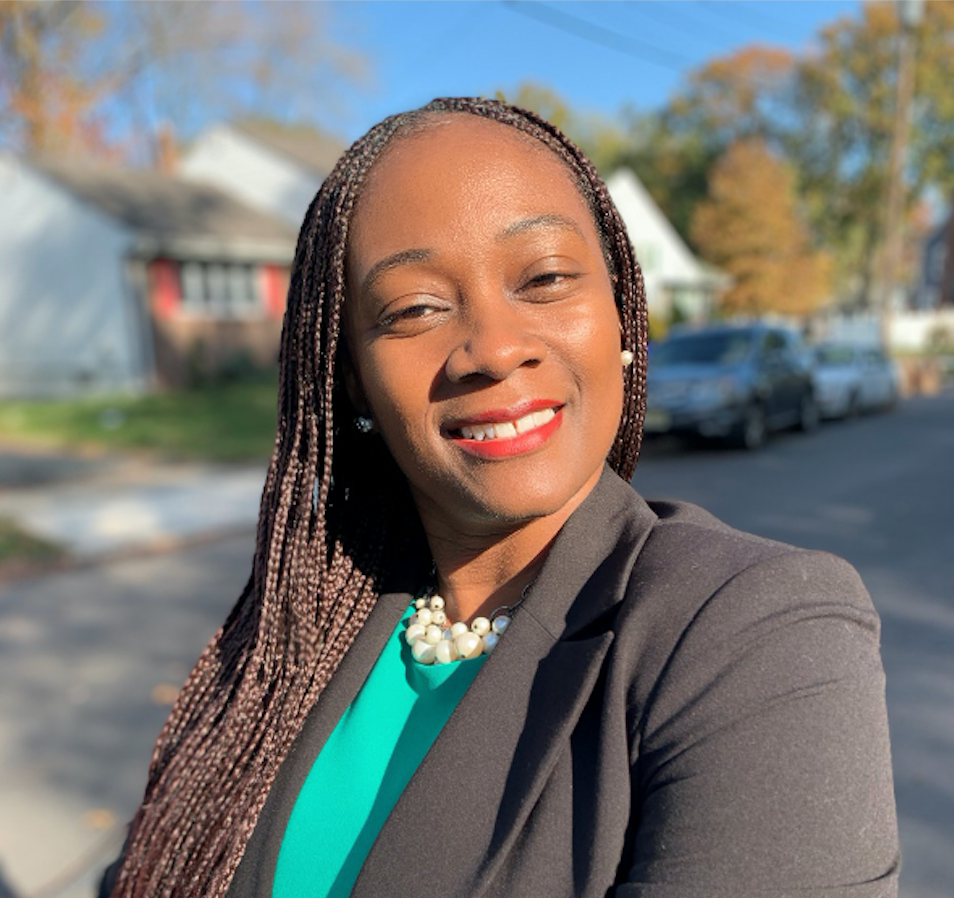
Shondelle C. Wills-Bryce, MSW
Shondelle C. Wills-Bryce, a master’s level administrative social worker, public speaker and conversation facilitator founded Sisters Keeping In Touch, inspires to help millennial women thrive and not just survive. Shondelle has developed personal resilience having lost her mother to Breast Cancer at 18 months and aging out of New York’s foster care system. Shondelle is the mother of two amazing young women and she is married to her husband and best friend who motivate her each day.
Welcome to the Council on Accreditation (COA) blog post series Profiles in Accreditation!
The organizations that COA accredits are diverse in both the communities they serve and their reasons for seeking accreditation (or reaccreditation). Profiles in Accreditation will explore the accreditation experience through the perspective of these organizations. Through them, we can discover the value of accreditation, best practices, lessons learned, and recommendations.
Organization profile
Name: Ranch Ehrlo Society
Locations: Regina, Prince Albert, Moose Jaw, Fort Qu’Appelle, and the Rural Municipalities of Edenwold, Corman Park, and Buckland, Saskatchewan, Canada
First accredited: 1977
Reaccredited: 2019
Snapshot: Ranch Ehrlo, a non-profit organization, was founded by the late Dr. Geoff Pawson in 1966. It started as a single residential unit for six troubled boys and grew to a multi-service agency that serves thousands every year. Ranch Ehrlo offers a wide range of accredited mental health and developmental services on campuses located in and around Regina, Saskatoon, and Prince Albert, in the Canadian province of Saskatchewan. Its services include assessment and psychotherapy for members of the broader community, family treatment and reunification, early learning, vocational training, emergency receiving services, treatment foster care, affordable housing, residential treatment and education for children and youth with mental health and addictions needs, residential care for older adolescents and adults with pervasive and complex developmental disorders, and community recreation and sports programs for at-risk youth. Clients are referred to Ranch Ehrlo from across the country.
Ranch Ehrlo’s mission isto provide quality preventative and restorative services to, and advocacy for, vulnerable individuals and families through highly engaged and professional employees. Itenvisions communities where all individuals and families achieve their full potential.
Ranch Ehrlo is guided by the CARE model, Children And Residential Experiences: Creating Conditions for Change. Developed by Cornell University, CARE is a multi-level program aimed at improving services for children and youth in care. Based on six guiding principles (developmentally focussed, family involved, relationship based, trauma informed, competence centred, and ecologically oriented) the CARE model is designed to significantly influence the way professionals work with children.
Interview with Ranch Ehrlo Society
For this Profiles in Accreditation post, we asked Ranch Ehrlo President and CEO Andrea Brittin to share her experience of the COA accreditation process at a large organization that dedicated itself to becoming accredited not because of a mandate, but because of a passion for best practices. Ms. Brittin emphasized how accreditation has encouraged growth and enhanced cohesion across the agency.
* * *
COA: Why was seeking initial accreditation important for your organization?
AB: In the early 1970’s, Ranch Ehrlo Society sought to obtain accredited membership with the Child Welfare League of America (CWLA) to assist in the development of sound policies, procedures, and standards of practice. As the CWLA was one of the founding members of COA, it was a natural progression for us to seek accreditation from this body to validate our effectiveness and keep abreast of the latest in research and best practice.
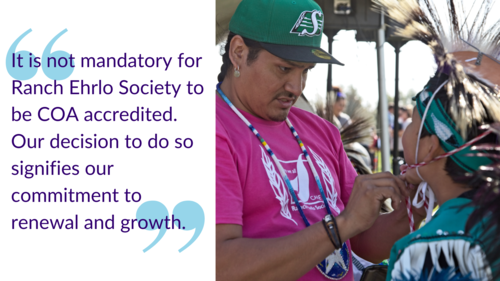
COA: What were some of the drivers for seeking reaccreditation?
AB: Ranch Ehrlo Societystrongly believes that maintaining best practice, as well as continual self-assessment, aids quality improvement and rejuvenates the agency. This benefits both those we serve and agency personnel. Undergoing the process of reaccreditation demonstrates that we, as an organization, continue to effectively manage our resources, allowing us to accomplish our goals. The reaccreditation process is one of many strategies we use to assist in stabilizing, measuring, and validating our effectiveness, ensuring that we are kept highly informed of the latest research and practice in the human services field. Our organization has grown exponentially since we were first accredited more than 40 years ago, so it is essential to have a method of review in place to be sure all elements are functioning smoothly.
COA: What about the COA accreditation process made you decide to partner with us?
AB: For clients and participants, COA accreditation demonstrates:
- Best practices carried out by appropriately trained staff.
- Client participation in their own service planning.
- A safe and respectful environment.
- Privacy protections of their confidential information.
- Positive outcomes.
- Cultural competence.
For employees, it demonstrates:
- Focus on health and safety with minimized risks.
- Efficient, effective, and supported environments. Defined professional staff qualifications. Performance evaluation and employee development in a culture of excellence.
For the board, it demonstrates:
- Sound financial management.
- Ethical practices.
- Current, relevant, and monitored strategic plan. Effective performance, quality improvement and risk management systems.
- Policies and procedures address pertinent issues.
For Funders and Referral Agencies, it demonstrates:
- Validation of high-quality services.
- Sound financial practices.
- Performance and quality improvement.
- Efficient organizational operations.
- Effective risk management policies.
COA: Were there any unexpected results after completing the Self Study and PQI process?
AB: We are very proud that COA standards and expectations have been engrained in the fabric of Ranch Ehrlo Society. New quality improvement initiatives, process developments, or procedure amendments are not undertaken “for COA”. These tasks are welcomed, as they are a testament to the value the agency places on continuous improvement. Although self-examination is not always simple, especially when obstacles are presented, the agency has learned to relish the challenge, with the solid best-practice framework and support COA offers. Comfort with self-reflection is an organizational shift from previous accreditation cycles.
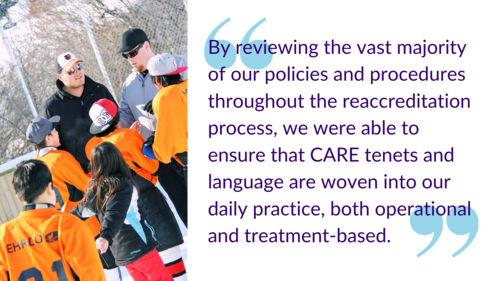
COA: How did you engage and communicate the value of accreditation to the entire organization during the accreditation process?
AB: A team of subject matter experts was appointed to each of the 21 sections/sub-sections of standards assigned to Ranch Ehrlo. These teams, in tandem with the quality improvement department, examined the standard implementation required and orchestrated the collection of evidence. This approach allowed investment in the process by a greater population of personnel.
Throughout the year leading up to the Self Study submission and Site Visit, communication to agency employees was ongoing. Emails, website stories, standing agenda items at departmental or program meetings, etc.–all worked simultaneously to ensure staff were informed and engaged.
All agency employees, regardless of position, program, or location, had the opportunity to partake in the process. There are various ways this occurred – from composing a written narrative, to offering input for policies in development, to being informally interviewed or observed during the Site Visit, to learning about the process through agency communications. This provided a sense of ownership in the agency’s intentions and functioning.
COA: What do you see as the main benefit of COA accreditation?
AB: We at Ranch Ehrlo strongly believe that adhering to best practices, as well as continual evaluation, helps us enhance our services for the young people, adults, and families we serve. For that reason (and many more), we choose to pursue accreditation as a means to periodically and thoroughly review EVERYTHING we do. It is not mandatory for Ranch Ehrlo Society to be COA accredited. Our decision to do so signifies our commitment to renewal and growth. COA offers extremely thorough training, documentation, and support throughout the process, so, although accreditation is a great deal of work, guidance was always available.
COA: What about the accreditation process do you feel was most valuable to your organization?
AB: The self-study process is always a valuable opportunity for reflective practice and learning. In the past, it has proven so impactful and valuable for staff to hear the comments of Peer Reviewers at the Exit Meeting, and to read about strengths and areas for improvement in the Final Accreditation Report.
Also, Ranch Ehrlo Society has been in the process of implementing the CARE (Child and the Residential Experience) Model of treatment over the last two years. All agency employees, regardless of role, tenure or location, have been or will be trained in the model, and continual training is offered to direct-care staff. By reviewing the vast majority of our policies and procedures throughout the reaccreditation process, we were able to ensure that CARE tenets and language are woven into our daily practice, both operational and treatment-based.
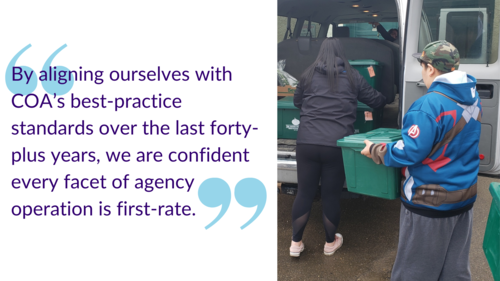
COA: What did you like most about the accreditation process?
AB: It is a collaborative process that requires numerous departments, programs and personnel to work closely to review policies and procedures and to evaluate the degree of standard implementation. By engaging collectively with colleagues, a cross-section of staff from a variety of areas were reviewing information, so processes were examined more thoroughly and under a variety of lenses. This led to a greater understanding and appreciation of the organizations’ functioning, allowing for enhanced cohesion.
The Site Visit was also extremely beneficial, as it provided real-time advice and feedback from the Peer Reviewers and gave employees a face-to-face connection with COA. The visit allowed us to demonstrate our successes, but we were also not afraid to have our challenges highlighted. This truly allows for reflective practice and growth.
COA: What was the biggest challenge during the accreditation process?
AB: Ranch Ehrlo Society is a large organization, with close to 900 employees working in dozens of programs and locations across the province of Saskatchewan. We were assigned 21 different sections of standards and submitted over 1000 documents for our Self Study. There was a great deal of organization and communication required to coordinate review teams and evidence.
COA: How has COA (re)accreditation impacted operational success?
AB: Ranch Ehrlo Society firmly believes that accreditation improves the overall quality of care for those we serve. By aligning ourselves with COA’s best-practice standards over the last forty-plus years, we are confident every facet of agency operation is first-rate. COA has given us the opportunity to strengthen our continuous improvement efforts and enhance our programming, while establishing a highly-competent workforce and supporting our mission. The process makes us more cognizant of proactively reviewing and, if required, revising policies and procedures and other agency operations.
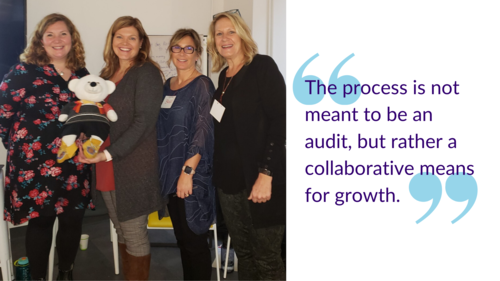
COA: What are the top three pieces of advice or tips that you would give to an organization considering or currently undertaking the accreditation process for the first time?
AB:
- Be sure to give yourself PLENTY of time to prepare for each phase of the process. Some required documentation or processes will already exist, but many others will have to be revised or created. Set due dates well in advance of final submission deadlines. It may take much longer than you anticipate preparing evidence and implement procedures. Carve out time in your daily calendar to complete COA-based tasks. This will keep you on schedule.
- Thoroughly review the standards prior to beginning the implementation review and document collection process, noting where information is required from a cross-section of departments. For example, the Residential Treatment Services Standards (RTX) may be the focus for employees working in those programs, but they will likely require collaboration with Human Resources for staffing lists, training information, etc. This will avoid scrambling for evidence when due dates approach.
- Depending on the size of your organization, the Stakeholder Survey process may be a much larger project-within-a project than anticipated. Collecting the contact information and engaging the assistance and input of hundreds of stakeholders across the country was a challenge for our agency.
COA: Are there any other learnings or insights that you’d like to share?
AB: Fully embrace the accreditation process. It is not easy, and it extremely time consuming, but it is all worth it in the end. Delve into the COA-offered trainings, both in-person and online and connect regularly with your accreditation coordinator with COA. The process is not meant to be an audit, but rather a collaborative means for growth in an organization. Do not be afraid to highlight areas of challenge or where improvement is required. That is the intention of the process. No organization is perfect, but accreditation can assist each organization in living up to their full potential.
Thank you, Ranch Ehrlo Society!
We would like to express our gratitude toward Ms. Brittin for her inspiring insights and tips and acknowledge the entire Ranch Ehrlo team for embracing accreditation and collectively contributing to the promotion of best practices. Thank you, all!
Do you have a COA accreditation story to tell? Click here to share it. You could be the next organization we feature!
Welcome to the Council on Accreditation (COA) blog post series Profiles in Accreditation!
The organizations that COA accredits are diverse in both the communities they serve and their reasons for seeking accreditation (or reaccreditation). Profiles in Accreditation will explore the accreditation experience through the perspective of these organizations. Through them, we can discover the value of accreditation, best practices, lessons learned, and recommendations.
Organization profile
Name: Rose Brooks Center
Location: Kansas City, Missouri
First accredited: 2018
Snapshot:Rose Brooks Center is a domestic violence agency serving the Kansas City Metro-Area. Its mission is to break the cycle of domestic violence so that individuals and families can live free of abuse.
Rose Brooks Center services include a 24 hour crisis hotline; a 100-bed emergency shelter for adults, children, and their pets; individual and group therapy services; a supported recovery program; advocacy services co-located within 5 hospital systems, civil and criminal courts, and the police department; a rapid re-housing program; residential and non-residential case management services; employment and economic advocacy; a school-based violence prevention program serving over 30 local schools; and community training and education.
Interview with Rose Brooks Center
For this Profiles in Accreditation post, we asked Chief Operating Officer Lisa Fleming to share her experience heading up the accreditation process at an agency becoming accredited for the first time. Lisa emphasized how accreditation has enhanced Rose Brooks Center’s quality improvement and risk management processes, and how the hard work of the Self Study can pay off.
COA: Why was seeking accreditation important for your organization?
LF: For several years, Rose Brooks Center had the goal of obtaining accreditation in our strategic plan. We were fortunate to have a local funder, the Jackson County Community Mental Health Fund, that offers agency capacity-building grants for improving mental health outcomes. Specifically, they provide funding to grantees to pay for accreditation fees. Since the early 90’s, the Mental Health Fund has provided Rose Brooks Center with leadership and guidance in using outcome data and quality assurance indicators to make improvements to our funded programs. Their capacity-building grant helped to ensure we moved to the next level of fully implementing best practice standards and building out our quality improvement process.
We recognized that accreditation would be the next step for ensuring quality services. It would also be important to sustaining a culture of quality improvement. While we had general policies and procedures in place for agency operations, we knew we would benefit from the structure and researched best practice standards offered by COA.
In addition, we have benefited from the institutional knowledge of several agency leaders who have been here for twenty or more years. As we planned for the next five to ten years, we knew that there needed to be a way of transferring this institutional knowledge and formalized processes for ensuring quality.
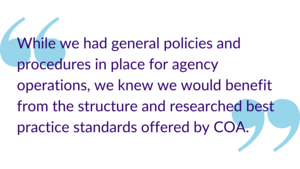
COA: What about the COA accreditation process made you decide to partner with us?
LF: There were several factors that influenced our decision to partner with COA. First, the COA process includes standards specialized for domestic violence services and emergency shelter operations. These standards reflect guiding principles of trauma-informed care and the standards set forth by our state domestic violence coalition.
Two of our local domestic violence agency partners had also selected COA and highly recommended COA. We benefitted from their lessons learned and work product as we conducted our Self-Study. We hope to pay it forward to another domestic violence program considering COA.
The consultation with our Accreditation Coordinator was a benefit that was not originally factored into our decision, but certainly was one that was extremely helpful and valuable to our self-study process. We always highlight this service to other agencies who are in the process of selecting an accreditor.
COA: Were there any unexpected results after completing the Self Study and Performance and Quality Improvement (PQI) process?
LF: The level of staff participation throughout the Self Study and ongoing PQI process has exceeded our expectations. It has been a valuable and effective way to instill a culture of improvement throughout the agency, and it has offered a professional development opportunity for staff who have an interest in program management. Recently, a PQI Team member expressed her interest in being a full time PQI Coordinator if the position was ever created. It was a result affirming our original goal of sustaining a culture of improvement.
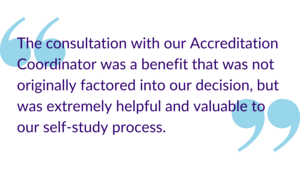
COA: How did you engage and communicate the value of accreditation to the entire organization during the accreditation process?
LF: We used many of the Intensive Accreditation Training and Performance and Quality Improvement Tool Kit documents to train staff, agency leadership, and the board. At our first staff training we used the Culture of Improvement document, and staff shared examples of Rose Brooks Center practices that supported each component of a culture of improvement. The activity and document helped connect staff to the things they do on a regular basis but may not have considered to fit with the more formal definition of Performance and Quality Improvement. We did a similar presentation with our board to share the benefits of accreditation, explain the self-study process, and train on the new or updated policies and procedures.
COA: What do you see as the main benefit of COA accreditation?
LF: COA accreditation sustains a foundation of research-based best practices throughout our organization. This helps to ensure that our agency achieves our intended outcome goals, exceeds our indicators for service delivery quality and safety, and manages agency operations with the highest degree of ethical and fiduciary standards. The accreditation process and resulting new or updated policies and procedures continually inform and guide our program development and improvement, training and professional development, risk prevention and management activities, and overall agency capacity building activities.
COA: What about the accreditation process do you feel was most valuable to your organization?
LF: Establishing routine and formalized processes for agency-wide performance and quality improvement and risk prevention and management that will be sustained long-term. Concurrent to the self-study process, our agency has continued to work on succession planning and staff professional development. Several staff with over 20 years of institutional knowledge will retire within the next 5 to 10 years. The accreditation process has been incredibly effective in transferring the institutional knowledge, expertise, and processes that have resulted financial stability and quality services to the next generation of leaders.
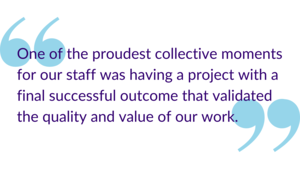
COA: What did you like most about the accreditation process?
LF: One of the proudest collective moments for our staff was having a project with a final successful outcome that validated the quality and value of our work. Seeing the volume of evidence describing all that staff do on a daily basis was a pretty great feeling.
We appreciate having the researched-based standards offered by COA, as well as the flexibility and empowerment to create agency procedures that can both fulfill the requirements of the standards and be customized to meet the unique needs our workforce and the people we serve.
COA: What was the biggest challenge during the accreditation process?
LF: Managing a full time position while working a project that could in itself be a full time job position. It’s worth it. But it’s a lot. Thankfully, I had a great team of supervisors and staff to help with the project. We also appreciated the help from Sabrina (our Accreditation Coordinator) in determining a reasonable timeline for completion.
COA: How has COA accreditation/reaccreditation impacted operational success?
LF: COA accreditation has formalized our Performance and Quality Improvement (PQI) and risk prevention and management processes. In turn, we have been able to include these up-to-date recommendations and improvement needs into multiple grant proposals. The monitoring and improvement processes provide our grant writers with timely, detailed, and substantiated Statement of Need for a wide variety of local, state, federal, and foundation grants. We have been awarded funding for program enhancements, staff training, equity and inclusion consultation services, facility and security improvements, and client supplies using PQI and risk prevention and management data.
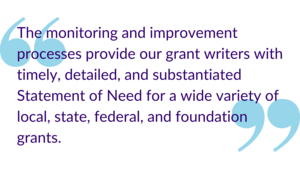
COA: What are the top three pieces of advice or tips that you would give to an organization considering or currently undertaking the accreditation process for the first time?
LF:
1. Use the tools, documents, training, and consultation offered by COA. Our monthly meetings with our Accreditation Coordinator, Sabrina, were extremely helpful to increasing our understanding of the standards and thinking through what needed to be developed or what existing procedure could be adapted to fit with a standard. They were also a reassurance that COA’s goal was to help us successfully achieve accreditation.
In addition, I would also recommend sending the staff person with the primary responsibility for coordinating the self-study to the in-person Intensive Accreditation and the Performance and Quality Improvement training offered by COA.
2. Reach out to another similar agency who has gone through COA’s self-study and site visit process. Most are very willing to share their policies and procedures. It can really help you get past a “writer’s block” and get you started. Likely they can help re-assure you about the process and its benefits.
3. Designate a leader and a team that has an expansive and detailed knowledge of agency operations to coordinate the self-study process. At first we hired a consultant to do the coordination, but the volume of concurrent projects, processes to be developed, and constant communication proved challenging for an external position. For our agency, it worked best to have the COA Coordinator (our Chief Operating Officer) develop a timeline and document checklist using the COA tools. The COA Team, comprised of program directors and the Executive Team, met at least monthly to review progress. Program directors involved their team members to update or create program-specific procedures.
COA: Are there any other learnings or insights that you’d like to share?
LF: Personally, the self-study process was one of the most challenging projects I have worked on in my 28 years at Rose Brooks Center. It is also one that I take the most pride in having led. As an Executive Team, it has given us increased confidence that the culture of improvement and our commitments to safety, quality, trauma informed- care, and equitable and inclusiveness will be sustained.
Thank you, Rose Brooks Center!
We would like to thank Lisa for her thoughtful insights into the first-time accreditation process and acknowledge the entire Rose Brooks Center board and team for embracing accreditation and collectively contributing to the promotion of best practices. Thank you, all!
Do you have a COA accreditation story to tell? Click here to share it. You could be the next organization we feature!
Welcome to the Council on Accreditation (COA) blog post series Profiles in Accreditation!
The organizations that COA accredits are diverse in both the communities they serve and their reasons for seeking accreditation (or reaccreditation). Profiles in Accreditation will explore the accreditation experience through the perspective of these organizations. Through them, we can discover the value of accreditation, best practices, lessons learned, and recommendations.
Organization profile
Name: Family Service Association
Location: Lincoln, Nebraska
First accredited: 1998
Latest reaccredition: 2019
Snapshot: Family Service is a nonprofit organization that has been providing services to the families of Lincoln, Nebraska for 125 years. They recently updated their mission to be “Helping Families Thrive.” Currently, Family Service provides families with four programs: Women, Infants, and Children; Child Care Food; Behavioral Health; and Out-of-School Time, which includes before- and after-school care, as well as summer care.
Two of Family Service’s four programs are accredited with COA: Behavioral Health and Out-of-School Time. Their Out-of-School Time program is their largest program. It consists of 14 before- and after-school care programs and seven Community Learning Center programs. Their Behavioral Health program provides licensed therapists to 22 schools within Lincoln Public Schools and six schools in Saunders County. It also includes of a Community Response Program, which connects families with community resources that will support families to meet their goals and strengthen relationships within the community.
Interview with Family Service Lincoln
For this Profiles in Accreditation post, we asked Director of Strategic Initiatives Jessica Radford, Ed.D. to share her experience at an organization that has been accredited by COA for the last ten years. Jessica told us how reaccreditation has helped drive the organization’s quality improvement forward. She also shared how she appreciated how COA accreditation felt not like an evaluation via checklist, but an effort from a team.
COA: What were some of the drivers for seeking reaccreditation this latest time around?
JR: It was important for our organization to seek reaccreditation to learn how quality programs and services are defined and to help us identify areas of growth. All our Management Team was new within the past two years. Reaccreditation provided us with the opportunity to really dig into the organization and its practices. We learned what was done historically, what was currently being done, and how we could improve it.
Accreditation helped us to evaluate and update practices that are oftentimes overlooked. Some of these included safety and risk assessments, HR audits, and an annual review of policies and procedures. It also helped us evaluate our system for communicating with staff and involving stakeholders. Sometimes we forget to evaluate our common organization practices and their effectiveness because we just keep doing things the way they’ve always been done. Accreditation helped us hone in on these practices and improve them.
COA: What about the COA accreditation process made you decide to partner with us?
JR: Our organization has been accredited with COA for the last ten years, and the staff take great pride in this accreditation. COA holds their organizations to high standards and has a rigorous accreditation process. So it was important for Family Service to continue this accreditation with COA for consistency, as well as to ensure we were providing good services to employees and families.

COA:How did you engage and communicate the value of accreditation to the entire organization during the accreditation process?
JR: We held a kick-off meeting where we brought everybody together and talked about the importance of accreditation, the process, and the role they would play. We provided updates through emails and meetings. When we received our accreditation, we had a cookie celebration and invited the board and stakeholders.
COA:What do you see as the main benefit of COA accreditation?
JR: The main benefit for us through our COA accreditation was the framework for evaluating and improving the organization and its practices. Sometimes it can feel overwhelming, not knowing where to begin with improvements or trying to identify what needs to be improved. COA provided a very thorough framework for us to follow, allowing us to assess the organization and its practices comprehensively so that we could target areas to work on. The standards also provided guidance for how to make improvements and what best practices are for nonprofit organizations.

COA: What about the accreditation process do you feel was most valuable to your organization?
JR: All of it. 😊
The standards were easy to understand and provided clear guidance. The staff at COA were very responsive and helpful. They always responded within a day anytime I emailed or called them, and they always had an answer for me. They were also very willing to take the time to help me and make sure I understood the process and standards.
The feedback given to us from our on-site reviewers was also very valuable and appreciated. For example, the on-site reviewers talked with us about the training of the organization. Following this conversation, we purchased an online training system and began implementing it. The system communicates with staff, tracks training completion, and provides lots of training options to staff.
COA: What did you like most about the accreditation process?
JR: I liked all the guidance that was provided through the accreditation process. The standards were very easy to understand and provided lots of explanations through the Interpretations. The staff at COA were so knowledgeable and helpful. The Intensive Accreditation Training was full of great information and guidance. Our on-site reviewers provided lots of great feedback on areas we can improve. The process really felt like a team effort.

COA: What was the biggest challenge during the accreditation process?
JR: Organizing all the evidence. 😊
I found it helpful to organize the standards and evidence into tables. I put together tables with three columns: Standard, Required Evidence, and Family Service Evidence. This helped me to keep track of what document went with what standard and to be sure I provided evidence for each of the areas of Required Evidence. It helped me organize it into more of a checklist.
COA: How has COA reaccreditation impacted operational success?
JR: The reaccreditation has really helped drive our quality improvement forward. It has given us specific areas to improve on and helped us set goals and objectives. It’s only been a few months since we received our accreditation and we have already made some great improvements.
Because of our accreditation, we have worked to improve the training we provide our employees. We have created an onboarding process which includes some safety trainings and some behavior trainings. We have created an annual training plan which includes monthly safety trainings for all staff and bi-monthly supervision trainings for all supervisors. The system we have implemented tracks trainings completed by staff in one on-line system. This has helped us to keep track of trainings as well as identify training needs for staff. This has not only improved our training program, but also the culture at our organization. Staff now feel that safety and training is a priority to Family Service.
We have also become more aware and thoughtful about reviewing our practices on a regular basis. We have implemented annual HR audits, stakeholder meetings and surveys to get feedback on our programs, annual reviews of policies and procedures to make sure they reflect what we are doing, quarterly safety checks and risk assessment reports, and improved data collection to help us analyze practices and programs.

COA: What are the top three pieces of advice or tips that you would give to an organization considering or currently undertaking the accreditation process for the first time?
JR: The coordinator of the process needs to be a very organized person. A large part of the process is collecting and organizing evidence to be submitted. If the person is already good at organizing projects and information, setting deadlines, and delegating duties, this will make the process less overwhelming.
Use your COA team. Do not be afraid to ask questions. Everybody on our COA team was so helpful. It felt more like a team effort instead of an evaluation and checklist.
Use the process as an opportunity to identify areas of growth. Do not try to look perfect for COA. Be honest about your practices and procedures. This will help you use the process to identify areas of growth and make improvements.
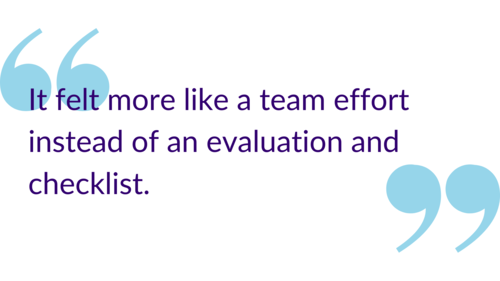
COA: Are there any other learnings or insights that you’d like to share?
JR: I cannot say enough good things about our accreditation team. Mary Glenn was amazing, and I couldn’t have done it without her. She was always so helpful and knowledgeable. Even when I felt overwhelmed or like we were doing things wrong, she helped guide me and reassure me that we were on the right track with things.
Our on-site reviewers were so pleasant and knowledgeable as well. They did a wonderful job at the introductory meeting explaining accreditation and the process to our board and staff. All our staff enjoyed having them on site and talking with them. Their feedback during the exit meeting was so valuable as well. It really gave us areas to improve on.
When we received our final accreditation report, nothing was a surprise because everybody had been so transparent through the process. It was really a team effort to get our accreditation, and COA was a big part of that team.
Thank you, Family Service Lincoln!
We would like to thank Jessica for her thoughtful insights into the reaccreditation process, and acknowledge the entire Family Service Lincoln board and team for embracing accreditation and collectively contributing to the promotion of best practices. Thank you, all!
Do you have an accreditation story to tell? Click here to share it. You could be the next organization we feature!
Too often great ideas are kept in-house without recognizing their potential to create change beyond the communities where they are born. COA’s Innovative Practices Award (IPA) identifies, documents, and celebrates examples of successful approaches to management and service delivery practices adopted by our accredited organizations.
In 2018, a committee made up of COA volunteers and staff selected 6 finalists from over 45 Innovative Practices Award submissions to move forward with a full case study. The St. Louis-based Foster & Adoptive Care Coalition’s 30 Days to Family® came out the winner. Read on to find out how 30 Days to Family® is leading the charge to create stability for kids in the chaotic world of foster care.
Seven siblings entered foster care when they were discovered in deplorable conditions with no food or water. With no known relatives in the area, they were split up between four separate, distant foster homes. Eight days after our team stepped in, all children were placed together, and, one year later, are still in the same home.
Maliek’s father’s beating sent him to the hospital. Lost to addiction, his mother was nowhere to be found. His grandmother, a refugee from the Rwandan genocide, wanted custody, but because she spoke limited English, the licensing team refused to accommodate her. His aunt also wanted custody but lived out of state. The Coalition stepped in to provide translation services and one-on-one training with grandma so she could become a licensed relative provider for Maliek while his aunt went through the lengthy ICPC process. One year later, Maliek was happily in the guardianship of his aunt, his grandmother living in to assist with childcare.
* * *
By the start of the opioid epidemic in 2011, the St. Louis-based Foster & Adoptive Care Coalition had become family-finding experts. We were the first agency in the country to utilize full-time private investigators, and our work was featured in The New York Times and TIME Magazine. But like everyone else, we were doing family finding for children who had already spent years in foster care.
Why were we waiting? We know that long-term foster care is bad for kids. We know that extended family experience deep grief because they’ve lost a child to the system for years. And we know that relatives often respond to requests for help by telling us, “I said I could help years ago, but then nothing happened.”
The Fostering Connections Act of 2008 mandated that all family members be alerted within 30 days of a child entering foster care, but we know that doesn’t happen. Lack of time, tools, and training mean a caseworker identifies an average of only seven relatives. Though a safe, appropriate family member could have been found, a nonrelative foster parent is called and, as a result, children suffer in isolation from their culture of origin, school, neighborhood, and church.
To make matters worse, Missouri does not have enough foster homes to deal with a steep increase in the number of children entering care due to the opioid epidemic. In the last 10 years, Missouri has seen a 42% increase in new entries, with more than 20,300 children spending time in foster care in 2018.
Realizing an opportunity to do better work up front, we created 30 Days to Family®.
30 Days to Family® is an intensive, short-term intervention that places children in the homes of safe and nurturing relatives within 30 days of entering foster care. It works because 30 Days to Family® Specialists are required to find an average of 150 relatives for each child or sibling group. In the last eight years, we’ve learned many lessons about how to find and engage family. Here are the top three:
Work fast
Every night in foster care for a child is a night in crisis. That’s why we initiate 30 Days to Family® the moment a child enters foster care. A member of our team attends the child’s first protective custody hearing to create a sense of urgency around the case. The more time a child spends in care, the more likely it is that relatives will fall away or disengage. Immediacy is key.
And that attitude of immediacy permeates every aspect of every case. If a relative expresses interest in providing placement, we drop everything and assess for safety on the spot. Relative foster parents shake up their entire lives when they agree to care for our kids; the least we can do is match their enthusiasm and flexibility.
“We operate from a mindset of ‘don’t put off tomorrow what can be completed today.’”
When it comes to 30 Days to Family® cases, regular business hours do not apply. We operate from a mindset of “don’t put off tomorrow what can be completed today.” The early tasks in a case are critical for setting the tempo and tone of everything that comes after. Our team never wants to let an opportunity slip through their fingers to find a safe, appropriate relative for a child and get the whole professional team on the same page.
But we don’t slow down once a relative steps forward. Our Specialists bring the same sense of urgency to support as to recruitment. We will not allow a disruption because daycare isn’t in place and the caregiver has to choose between a job and a child. This person became a parent days ago – they have a million things to deal with and calling daycares for openings or doctors for Medicaid eligibility distracts them from meeting the needs of the child in their care.
Engage everyone
When it comes to our kids, everyone has something to contribute. While they may not be able to take placement, a retired uncle may be able to transport the kids to appointments, grandma could watch them after school, or a cousin could help cook dinner on her nights off.
You simply never know when you will find a relative with something amazing to give. To that end, we will contact every living adult relative despite their background, criminal history, abuse and neglect history, social situation, or living conditions. Even if they aren’t appropriate for placement, they may know of a long-lost relative who will prove invaluable in supporting the family. Everyone has a piece of the puzzle.
Often, our team will hear that an aunt or grandparent doesn’t want to be involved – they had enough of mom and dad years ago. Or maybe they don’t trust the child welfare system. A key to our success has been to never take that at face value. We always reach out to hear their story, and often find that if we listen actively and with empathy, they will become an active part of the child’s life.
Another thing that sets 30 Days to Family® apart is its commitment to involving paternal relatives. We do not wait for paternity to be established to reach out, as we’ve found that cousins or grandparents will often step up if they know the children. Biological relation is not a deciding factor for many of our caregivers. Many will ask for placement even after a conclusive paternity test shows they have no relation to the child.
However, we do always attempt to establish paternity. We know kids do better when they’re connected to family. To that end, we’ll do our best to give them as much information as possible. We’ve even begun conducting our own paternity tests to speed things up.
Support always
“Focusing on natural supports strengthens the caregiver’s existing social network, offers more flexibility, and gives kids more relative connection.”
Just as important as finding a relative placement is putting an end to what we call “relative dumping”– you know, when grandma is asked to take in her four grandkids with no support. Say grandma has a good job at a factory, but inflexible shifts. Suddenly, all the kids in her care need physicals, dentist appointments, psychological exams, new school enrollment, court dates, and team meetings – all within a month. Instead, our team utilizes our proprietary Roadmap to Family, which guarantees all formal and informal supports are in place to keep grandma focused on caring for her grandkids.
The Roadmap to Family is a thorough, culturally competent plan created in concert with the family. Everyone has buy-in and makes a commitment. Our team focuses on “natural” supports rather than “prescribed” supports: We’ll find a cousin to take the kids to their doctor’s appointments rather than rely on public transportation, or an aunt who is a math teacher instead of hiring a tutor to help with homework. Focusing on natural supports strengthens the caregiver’s existing social network, offers more flexibility, and gives kids more relative connection.
Another key to 30 Days to Family® is the inclusion of backup placements, often more than one. Should a placement disrupt, having multiple relatives lined up to step in ensures that the kids stay with family and are not forced to go to a stranger’s home. It eases the burden on overworked caseworkers, who otherwise might place the child in residential care due to a shortage of available nonrelative foster homes. Our team fully vets each backup as though they were taking immediate placement, so there is as little friction as possible in the event a disruption happens.
Finally, we conduct intentional, direct follow-up with caregivers at two weeks and 30 days after the end of services. We want to know if and how they’re utilizing the Roadmap to Family, if there’s any support they lack, any barriers they’re facing, or if they feel there’s any risk of the child disrupting. We want to make sure they feel supported and set up for success. If the caregiver needs anything, our team jumps back in – whatever needs to happen to minimize the disruption in the child’s life.
What’s in it for our kids?
In 2015, we secured funding for a multi-year, independent study of the 30 Days to Family®. Dr. Anne Atkinson with PolicyWorks, Ltd., a think tank based in Virginia, matched children served by 30 Days to Family® with comparable children who received services that were business as usual. The results were stunning. Children served by 30 Days to Family® exited foster care 91.4 days earlier on average. If the child had an identified disability, s/he exited foster care 257.8 days earlier. Not surprisingly, most children achieved permanency through reunification, adoption by their relative, or guardianship, reducing the need for nonrelative adoptive homes. Also, children served were half as likely to spend time in an institution (26% vs. 14%). Excitingly, children served were 81% less likely to experience placement disruptions.
By increasing permanency and stability and reducing the toxic overuse of residential treatment, 30 Days to Family® has created resilient placements which created a wide range of benefits for children, such as:
- More positive relationships with mom (61% served vs. 30% not served)
- More connection to paternal relatives (79% vs. 29%)
- Greater involvement in extra-curricular activity (60% vs. 45%)
- Higher employment for working-age teens (60% vs. 21%)
Additionally, Dr. Atkinson’s study was the first economic child welfare study of its kind in the United States. It demonstrated that every child served by 30 Days to Family® saves taxpayers an average of $10,217.61. Average savings increased to $21,687.26 for children nine and older. These numbers do not include intangible benefits such as reducing foster parent recruitment costs and easing caseworker workload. Neither does it include second-and-third-tier benefits, such as reduced Medicare costs and savings from lower percentages of children spending time in institutions. Our 30 Days to Family® Specialists can serve a minimum of 30 children per year, resulting in at least $300,000 in savings.
* * *
Family search and engagement takes work, but the rewards are worth the up-front investment of your time and resources. 30 Days to Family® represents the way forward for an overburdened child welfare system. By deepening family involvement and relationships, we build resilience among our most vulnerable children and increase buy-in in our community. By creating stability in their chaotic lives, we give our kids a chance at a genuine childhood, in which they can develop meaningful, long-term relationships, succeed in school, and pursue their passions. By being good stewards of public resources, we model responsibility and accountability. By rigorously evaluating and means-testing our own work, we set a precedent that children in foster care deserve the best we have to offer.
If your organization is interested in the 30 Days to Family® model, please contact the Foster & Adoptive Care Coalition’s Director of Program Replication, Melanie Moredock, at melaniemoredock @ foster-adopt.org.
The views, information and opinions expressed herein are those of the author; they do not necessarily reflect those of the Council on Accreditation (COA). COA invites guest authors to contribute to the COA blog due to COA’s confidence in their knowledge on the subject matter and their expertise in their chosen field.
Melanie Moredock
Melanie began with the Foster & Adoptive Care Coalition in 2011. Melanie’s previous child welfare experience includes residential treatment, specialized case management, and foster/kinship parent training and licensing. Melanie obtained her Juris Doctorate from Saint Louis University School of Law and has been a member of the Missouri Bar since 2007. Melanie’s passion is engaging and empowering family members, as well as working closely with the professional team members to ensure the laws regarding relative/kin placement are followed. Melanie enjoys sharing her knowledge of the program with others through providing individualized training and consultation to interested agencies and supervision of the 30 Days to Family® replication sites.
Welcome to the first in a new series of blog posts entitled Profiles in Accreditation!
The organizations that COA accredits are diverse in both the communities they serve and their reasons for seeking accreditation (or reaccreditation). Profiles in Accreditation will explore the accreditation experience through the perspective of these organizations. Through them, we can discover the value of accreditation, best practices, lessons learned, and recommendations.
Organization profile
Name: Lad Lake
Locations: Milwaukee and Dousman, Wisconsin
First Accredited: 2014
Reaccredited: 2018
Snapshot: Lad Lake has been evolving to meet the needs of Wisconsin’s most vulnerable children for 170 years. Serving more than 1,200 youth annually, the organization’s 300 staff accomplish its mission of “guiding the growth of at-risk youth to reach their potential and live responsibly” through four major program commitments: two residential care centers for youth who have experienced trauma from the child welfare and juvenile justice systems; alternative education for students with special learning needs; independent living services for youth “aging out” of the foster care system; and community services such as in-home therapy, specialized mentoring, and supervised visitation for parents and children.
Interview with Lad Lake
For our first Profiles in Accreditation post, we asked Lad Lake President and CEO Daniel O. Magnuson, MA, MSW to share his thoughts on his organization’s journey through reaccreditation. He emphasized how accreditation provided a framework for operational success, as well as the importance of having the entire organization–including the board–engaged with the process.
COA: Why was it important to Lad Lake to seek accreditation initially?
DM: We sought our initial accreditation in preparation for the retirement of a long-serving CEO; we wanted to position Lad Lake for improved impact and financial sustainability.
COA: What were some of the drivers for seeking reaccreditation?
DM: As we implemented the initial accreditation plan in 2014-2015, we also completed a comprehensive strategic planning initiative. COA’s accreditation framework helped us to focus and look at activities on an organizational level, which made the execution of our strategic plan more effective. Reaccreditation affirmed our internal sense that we were making significant progress in all domains of our performance, and in a dramatic fashion!
Additionally, accreditation provides Lad Lake with a competitive advantage with many of our stakeholders. This will be increasingly important as the federal Families First Prevention Services Act is implemented.
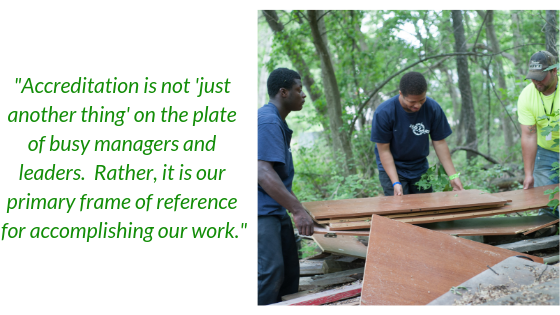
COA: What about the COA accreditation process made you decide to partner with us?
DM: Our partnership with the Alliance for Strong Families and Communities and our executive leadership’s deep connection with the Alliance network made COA the obvious choice for accreditation. It is the “gold standard” for our industry.
COA: What do you see as the main benefit of COA accreditation?
DM: COA accreditation provides Lad Lake with a framework for (and the discipline to stay focused on) our strategic priorities. It helps us to learn together, to adjust our approaches to achieve our intended impact, and to strengthen our financial sustainability in the face of changing market conditions.
COA: Were there any unexpected results after completing the Self Study and PQI process?
DM: The primary unexpected result was the degree to which Lad Lake’s management teams embraced COA accreditation, especially reaccreditation. The standards, the policies, and the procedures developed in our self-study and PQI processes have, for the most part, become the way Lad Lake does business. Accreditation is not “just another thing” on the plate of busy managers and leaders. Rather, it is our primary frame of reference for accomplishing our work.
Additionally, the COA accreditation and reaccreditation processes were completed in the face of very serious financial challenges. These challenges required the development and execution of a difficult turnaround plan. Rather than distracting our leadership from that plan, COA accreditation provided a disciplined process to focus our attention on the key drivers for our success.
As CEO, I do not believe our financial turnaround, improved quality and financial sustainability could have been possible without the discipline of thought offered by accreditation and reaccreditation.
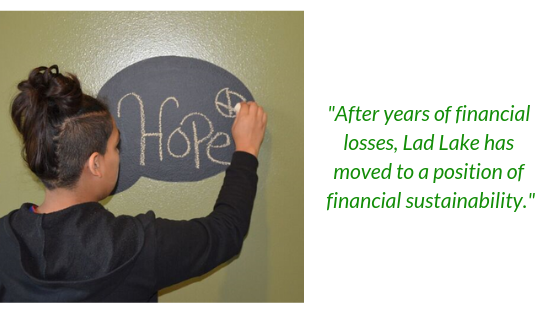
COA: Why was it important for you to have a high level of stakeholder engagement across your organization?
DM: One element of our organizational vision is to fulfill our mission with an “aligned, engaged, and happy workforce.” This can be a tall order in an industry with such challenging work and shoe-string budgets! The COA process, in concert with a clear strategic plan, helped us to articulate what we wanted employees to align and engage with. It also helped us to communicate those directions across our organization. This has grounded Lad Lake’s daily activities in a larger vision of improving the lives of youth and families in need.
COA: How has COA accreditation/reaccreditation impacted operational success at Lad Lake?
DM: Accreditation and reaccreditation has been transformative for Lad Lake. In concert with our updated strategic plan, COA provided a framework to operationalize and monitor our process improvements across all domains of our organization, from impact to human capital to financial sustainability to governance. A host of key performance indicators focused the work of the board, management, and staff.
The results have been extraordinary. All our programs now share common goals in safety, health, social support, and hopeful futures. Process improvement is closely tracked with client feedback and validated assessment methodologies. Findings inform refinements in program design. Risk management in many key areas has dramatically improved. After years of financial losses, Lad Lake has moved to a position of financial sustainability.
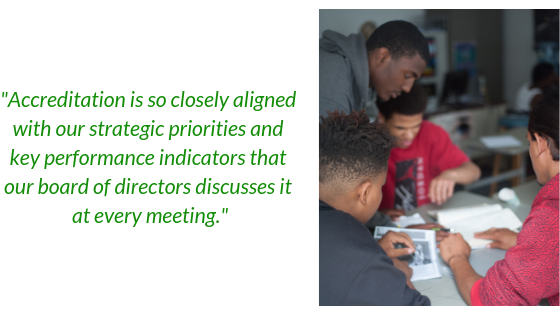
COA: How did you communicate the value of accreditation and engage the entire organization during the accreditation process?
DM: We did so in various ways. Firstly, many managers and supervisors were (and are still) involved in various teams devoted to quality improvement and risk management. Internal communication methods such as staff newsletters, email communication, and face-to-face meetings helped to extend the accreditation story to team members. Accreditation at Lad Lake is so closely aligned with our strategic priorities and key performance indicators that our board of directors discusses it at every meeting.
COA: At the board level, what were the driving factors for seeking accreditation?
DM: The board was particularly interested in accreditation to help it better understand and address the impact of the organization’s services on youth and families. The pending retirement of a CEO and the prospect of a new CEO coming aboard added extra urgency to Lad Lake’s initial pursuit of it.
COA: What was the biggest challenge for the board during the accreditation process?
DM: The board fully embraced accreditation. They understood its value and likened the process to quality initiatives and accreditation in their respective industries. Linking accreditation to our strategic planning and turnaround agenda required careful attention, but accreditation helped, not hindered, that process.
COA: What are the top three tips that you would give to an organization considering or currently undertaking the accreditation process for the first time?
DM: I would advise organizations to:
1. Embrace accreditation as the way you do business, not as an extra initiative to take on.
2. Embrace strategic planning. Find the right strategic planning process for you, and closely link accreditation with your strategic plan.
3. Communicate and engage your board of directors with COA. Many parallels may exist in their industries (e.g., Six Sigma, ISO 9001, Joint Commission, etc.).
Thank you, Lad Lake!
We would like to thank Dan for his thoughtful insights into the accreditation process and acknowledge the entire board and team for embracing accreditation and collectively contributing to the continued success of Lad Lake.
Do you have an accreditation story to tell?
Click here to tell us about it.
You could be the next organization we feature!
